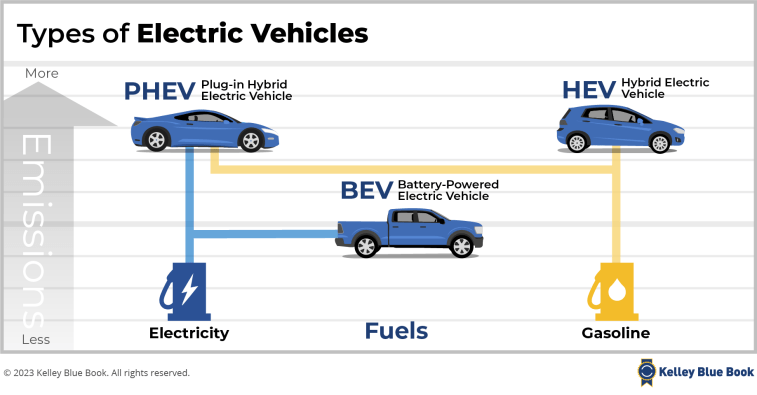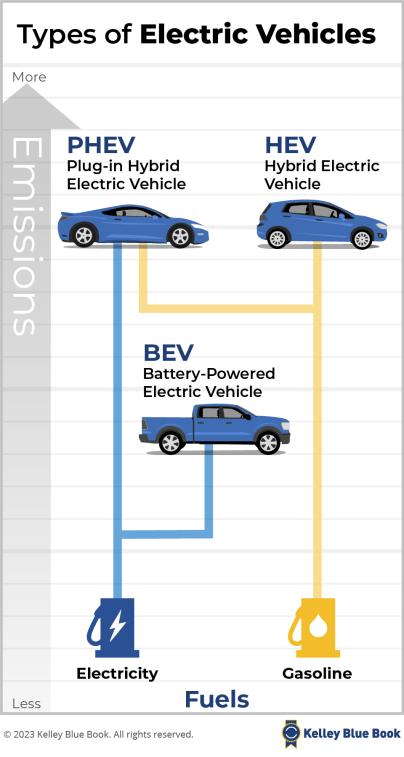Quick Facts About Buying an Electric Vehicle Now
- The supply of EV models is plentiful.
- Auto loan interest rates remain high.
- Electric cars’ average range will likely increase over the next couple of years as battery technology advances.
- You may qualify for a $7,500 government tax credit as a point-of-sale rebate, though fewer models are eligible this year.
If you are teetering on the brink of buying an electric vehicle (EV), you may well be asking yourself if you should buy a new EV now or wait. About 1.3 million of them were sold in 2024, but we understand you might have some hesitation. The economy, interest rates, confusing regulations on EV tax credits, and the high price of vehicles in general are only a few of the issues that may give you pause.
Our discussion here focuses on fully electric vehicles drawing all their power from a battery charged by plugging into an outside electric source. This excludes plug-in hybrids (PHEVs) and traditional hybrids (HEVs), which both have and rely on gasoline-fueled engines.
Let’s explore some of the issues we’ve raised, provide a few pros and cons for buying now, and then we’ll tell you what we would do if we were in your shoes.
- Electric Cars: What Do They Cost?
- Lack of Variety in Electric Vehicle Models
- Plentiful Supply in Automotive Market
- EV Tax Credits You May Consider
- Fluctuating Auto Loan Interest Rates
- Pros and Cons of Buying an Electric Car Now
- What Would We Do?
Electric Cars: What Do They Cost?
Today, the average price of a new EV in the United States is above $55,000. Correct, that is luxury car territory. Of course, it’s an average; therefore, some EVs are priced lower and some higher. Only a handful of electric cars are listed for sale below $40,000. For example, those below that threshold include (with destination charges) the Nissan Leaf ($29,280), the Hyundai Kona Electric ($34,325), and the Chevrolet Equinox EV ($34,995). The Kia Niro EV ($40,975) is just over that price point. Most cost much more; consequently, manufacturers have priced electric vehicles beyond the reach of the average consumer.
Chevy stopped making its Bolt EV and EUV with a planned return for the 2026 model year.
A few manufacturers like Nissan and Tesla have reduced their EV prices in the last few years. For example, Tesla dropped $2,000 from the price of its Model Y, Model X, and Model S vehicles in April. Those price cuts follow reductions made in 2023. Current electric car tax credit rules make many Tesla models eligible for the $7,500 credit. Prices for the Toyota bZ4x and Subaru Solterra have also come down.
These days, carmakers offer bigger incentives to entice consumers to buy electric vehicles.
For shoppers buying new EVs, Kelley Blue Book data shows carmakers offered an average incentive package of 13.7% of the transaction price, more than double the level seen one year ago.
Lack of Variety in Electric Vehicle Models
Despite the volume of new EV models carmakers continue introducing, there still isn’t near the variety of gasoline-fueled options. Moreover, if you are brand loyal, the choices narrow even more. For example, brands including Buick and Infiniti don’t yet offer an EV. However, nearly every car manufacturer has announced plans to produce EVs in the near future.
In other words, the options will increase with time. Consequently, if you can’t find exactly what you want now, you may be able to in a year or two.
Plentiful Supply in the Automotive Market
After the clogged supply chain and the microchip shortage that dogged the electric car supply chain in recent years, there’s no shortage of them to choose from these days. Inventory levels returned to about normal and incentives make the vehicles more enticing. Then there’s tax credits. Read on.
EV Tax Credits You May Consider
Some electric cars can qualify for a $7,500 instant rebate at the dealership, and used EV buyers might be eligible for as much as a $4,000 tax credit. We have covered many of the details elsewhere, and you can check them out in the latest version of our article on tax credits.
However, qualifying for the rebate or tax break depends upon your income. For example, the rebates are limited to individuals reporting adjusted gross incomes of $150,000 or less on taxes, $225,000 for those filing as head of household, and $300,000 for joint filers. It also depends on the price of the EV ($55,000 or less for cars and $80,000 or less for trucks and SUVs). To qualify, the EV must also be assembled in the United States, Canada, or Mexico, and there are restrictions regarding which origin of the battery materials — unless you lease.
Fluctuating Auto Loan Interest Rates
As the Federal Reserve looks to keep inflation in check, it could consider lowering the Federal Funds interest rate this fall. This is the rate banks charge one another for short-term loans, and it’s set by a committee of 12 Fed members. The Fed is the central bank of the United States. The federal funds rate is the leading influencer of the prime rate, which is the interest rate banks charge their very best customers when loaning them money.
Auto loan rates declined in December, although they began to rise again this month. The average used auto loan rate was 13.5%, while the new auto loan rate was 8.9% in early January. As a result of higher car prices and interest rates, the average monthly new car payment is a little more than $750. The average monthly payment was $795 in December 2022.
What’s Next?
The Fed recently suggested that it may not cut interest rates as far in 2025 as it had originally hoped. But the central bank still sees further cuts ahead this spring, possibly bringing a little relief for car shoppers.
“Rate policy is now expected to move only a half point in 2025, which is half of what they projected just three months ago,” explains Cox Automotive Chief Economist Jonathan Smoke. Cox is the parent company of Kelley Blue Book.
Consequently, with rates set to decrease again, some car shoppers might benefit from waiting. But since the drop is temporary, they shouldn’t wait very long.
RELATED: Roadblocks to Electric Car Ownership
Pros and Cons of Buying an Electric Car Now

We’ve tried to avoid wading too far into the weeds. However, itemizing the pros and cons of buying an EV now should clarify things a bit more. Remember, these pros and cons aren’t based on whether you should buy an electric car at all. These are based on buying an electric vehicle now rather than waiting a year or more.
Pros
- Interest rates — If interest rates on car loans drop later this year, it could be worth the consideration when coupled with other factors below, especially if you have your heart set on a new electric car.
- Suggested car retail prices — Today’s average price for an EV remains far out of reach for many consumers. However, manufacturer incentives, especially for the outgoing 2024 models, make it a great time to consider an EV at a substantial discount.
- Tax credit — For many, the best time to buy an electric vehicle was before some of the new tax credit regulations went into effect. However, today, there are fewer models eligible for the $7,500 tax credit. Still, it’s a great time to buy if one of those vehicles suits your needs, especially when the credit is paired with the manufacturer and dealer incentives. Check to ensure you meet income eligibility requirements.
- Plentiful inventory — In a fluctuating economy, demand for all new cars, including electric vehicles, could drop. Electric vehicle inventory is much higher than in the past couple of years. So, even if the MSRPs of electric cars stay the same, dealers be willing to negotiate lower prices.
Cons
- Range — Although we didn’t mention it earlier, range anxiety is still among the more cited reasons for holding off on purchasing an electric car. What does that have to do with whether you should buy now? Nothing really, other than the average EV range increased significantly in the past decade and they are becoming more efficient as time passes. Consequently, in a few years’ time, you can likely buy an EV with a longer range, compared with today.
- Timing — Prices are high, and interest rates remain elevated compared to pre-pandemic levels. If you don’t need a new car right now, you may do better staying on the sidelines until interest rates drop significantly. Higher interest rates can add a few thousand dollars to your bottom line.
- Depreciation — A George Washington University study found that EVs depreciate faster than gas vehicles. That said, longer-range electric cars may hold their value better. It’s a wait-and-see situation for now.
- Supply and variety — While all-new electric models are coming to market, many manufacturers cut back on the number of EVs they plan to produce after promising an all-electric future. For example, Volvo recently scrapped its plans to only sell EVs by 2030. With fewer EVs available than gas cars, there’s less to choose from. Last year, Chevy discontinued its Bolt, one of the least expensive EVs on the market. Look for a new version to appear for the 2026 model year.
- Battery degradation — A study by Toronto-based GeoTab, which studies battery health in fleet cars, finds that most EV batteries degrade 2.3% each year. While carmakers provide warranties on EV batteries of up to 10 to 12 years, the degradation findings may be enough to scare people off if you decide to sell your EV down the line. Read more: Hidden Costs of Owning an Electric Car.
What Would We Do?
If budgeting were our number one concern, buying sooner rather than later might be the better option. EV variety and supply are better than in recent years. And while MSRPs are still on the high side, average transaction prices are lower, thanks to generous manufacturer incentives and the immediate $7,500 federal tax credit on some models.
Some question how long that discount will remain available because the new administration in Washington opposes the tax credit for EV purchases. As for interest rates, another cut may come in the spring but rates won’t fall much by the end of the year.
So, take a test drive and see if you like the ride. If you can take advantage of charging at home, the vehicle fits your needs, and you aren’t overextending your budget, it might be time to make the switch.











